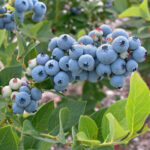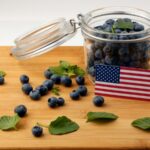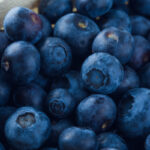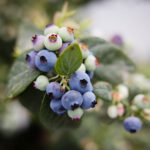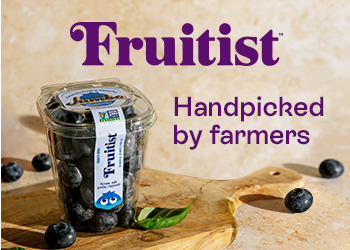Fall Creek releases six new blueberry varieties

Oregon-based Fall Creek Farm & Nursery Inc has released the first ever blueberry varieties from its own breeding program, catering to a wide range of climates and uses in a launch that has been 15 years in the making. President Dave Brazelton expects a quick take-up domestically, while the six varieties will be available through the company and licensed representatives in Canada, Chile, Europe, Mexico and North Africa.
Click here for photos of Fall Creek's new varieties.
While blueberries developed decades ago are still grown, Brazelton says "we've moved the goalposts" in terms of the demands placed on the fruit for cultivation, flavor and postharvest strength.
"The conditions under which they were released are different to the conditions under which they're grown and sold now; we're asking a lot more of this fruit," he says.
"Let's take the variety O'Neal. When it was first released in Chile it was hand harvested, hand packed and shipped by air and arrived three or four days later in a market in the U.S. Now we want to hand pick it, machine pack it, we want to put it on a boat and three or four weeks later we want it to arrive in great condition.
"That change in paradigm has really resulted in our biggest challenge; that is consistently good arrivals."
He says Fall Creek's team has rifled through "hundreds of thousands" of selections to come up with the six in this release, across 12 different trial stations in North America, Europe and Central America.
"We undergo extensive testing in regular and CA (controlled atmosphere) storage, in flavor, and in firmness, to try and stimulate the conditions to understand better how they may perform, and that’s a big focus of our breeding program.
"Always the challenge is climatic adaptation, but also horticultural adaptation of the varieties. Blueberries are grown in different ways in different soils and under different conditions.
He says any variety introduction is like a "three legged stool".
"One is genetics, two is the horticultural management and three is the climate and environment under which they’ll be grown. Those three express the fruit for the consumer.
"We work very closely with the market and we spend a tremendous amount of time in the fields, in the packhouses and with the retailers. We understand what they want, we look at consumer data very carefully, we try to understand that segment, and we think this focus is what will allow us to be successful in this venture."
The big six
The six selections include three mid-to-high chill blueberries focused on the fresh market, one evergreening low-chill blueberry, one machine-harvesting blueberry for processing, and one late-ripening rabbiteye.
The very early season variety is a southern highbush called Ventura, ideal for areas like Mexico and southern Spain, with a medium berry size, a vigorous plant and high yields.
Out of the four northern highbush varieties the first is the large early-to-mid season blueberry Blue Ribbon, with high yields and what the company claims to be "exceptionally flavorful fruit" intended for the fresh market.
The company is releasing two very different mid-season highbush blueberries - Clockwork and Top Shelf.
"We have one variety we’ve released 100% for processing – Clockwork. We released that variety because we see exceptional machine harvest and machine packing characteristics; highly adaptable, and it’s exceptional when it’s frozen and it’s thawed.
"It’s so firm, it’s almost like eating a fresh blueberry with high aroma and high flavor. It really fit for that niche but it wasn’t necessarily a niche for fresh market.
"Our two higher chill fresh market varieties, Blue Ribbon and Top Shelf, occupy a little bit different seasons and I think we may find different adaptations in climate or environment."
Top Shelf has a large/jumbo size and is designed for hand harvesting, although it does show potential for machine harvesting.
The late season highbush variety is Cargo, with a large size and extraordinary fruit yields; this variety can go to the fresh or frozen market and has shown machine-harvest potential.
The late season rabbiteye blueberry, Overtime, can be hand harvested and is ideal for the fresh market. Fall Creek says it can be used as a pollinizer for the existing Ochlockonee variety.
Adoption
Brazelton anticipates a pretty early adoption in the U.S. Pacific Northwest as there are many growers who have already seen them.
"I think there’ll be over 200 acres planted here in this first year of release. Chile is also going to adapt pretty fast because their need is so great, and the south of Spain I think because of growers have been able to see the performance of Ventura.
"We anticipate a slower adoption in other parts of the world because the growers are going to want to take a good look and trial first and we respect that.
"Growers should trial first and not take any larger risk than what they can afford. We have always counseled this when we’ve introduced new varieties. For some growers that may mean a major commitment because they’re comfortable, for other growers it may mean half a row."
Brazelton's son Cort, who is the company's farm and nursery manager, says he is particularly excited about the potential of these varieties in the western U.S., Chile, Europe, Mexico and North Africa.
"Fall Creek has a team of specialists in our key territories who are resident experts on these varieties, and we encourage our customers to ask questions," he says.
"The Fall Creek team have more data on these varieties than most releases in the past, and we are committed to sharing what we do and don't know.
Dave Brazelton says he is excited to be able to contribute to growers' choices, adding that new varieties - whether from Fall Creek or elsewhere - will have the answers for the next decades to meet grower needs.
"There can be more confusion because there’s going to be more choices, but if the net result is that we can improve arrivals and the eating experience, all good things will happen downstream. It starts there."
In the meantime, the 62-year-old plans to continue spending half his summers out in the field.
"We travel a tremendous amount. It’s also one of the few areas in our company that I still am actively involved out in the field.
"I really enjoy that work and I can’t quite leave it alone, so they have to put up with me."

















